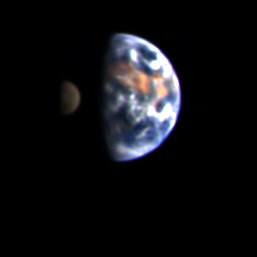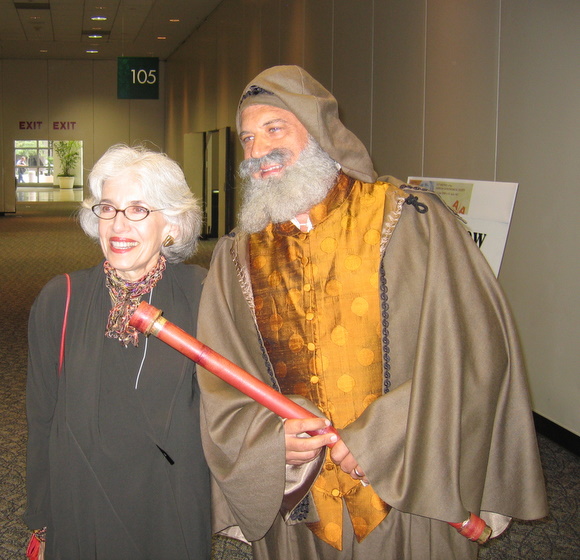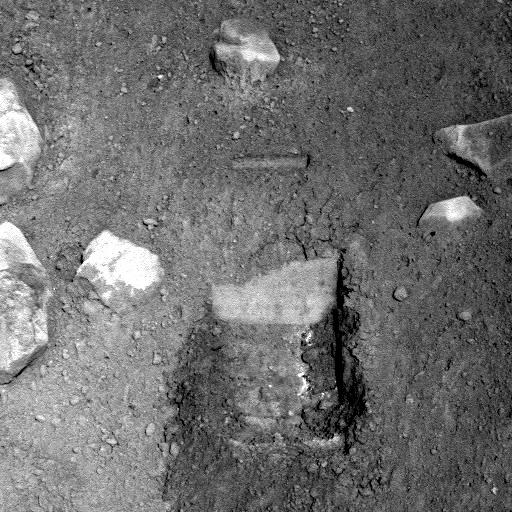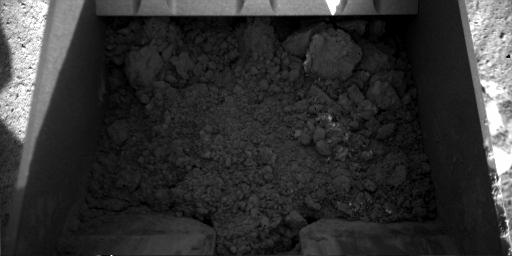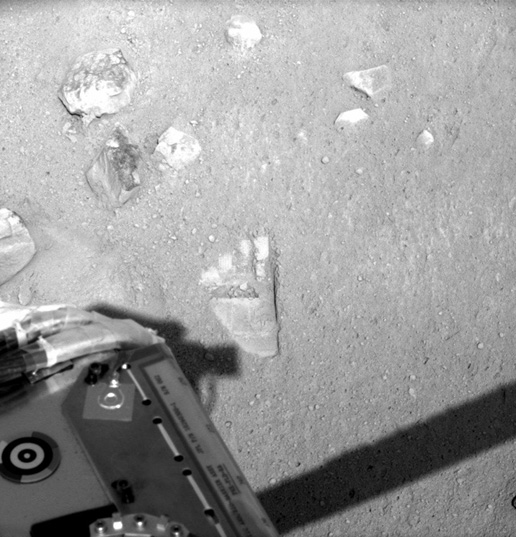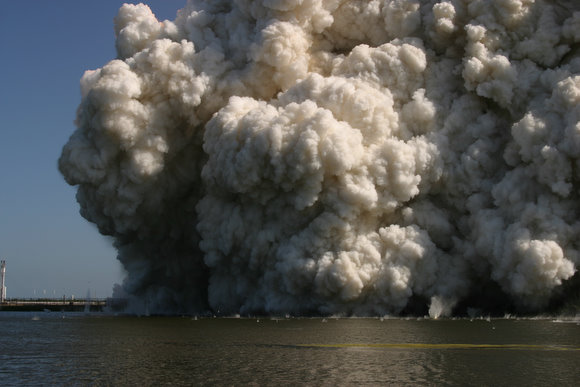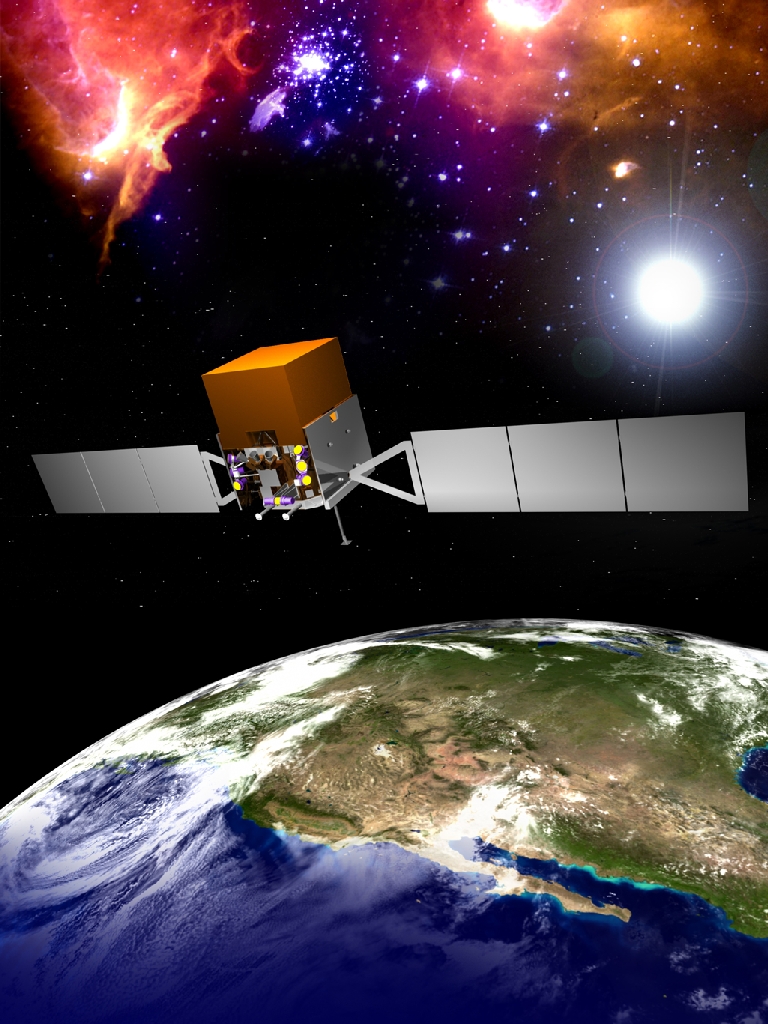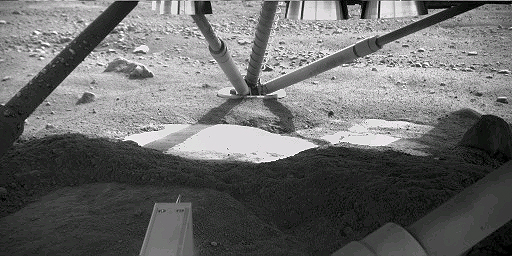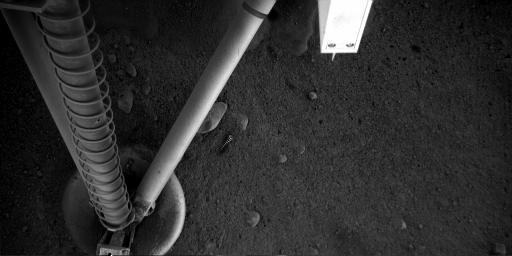The Milky Way is a large place, and getting all the stars together, even from just the inner galaxy, for a family photo requires a big canvas. The imaging team from the Spitzer Space Telescope today unveiled the largest, highest resolution infrared picture ever taken of the Milky Way. The photo spans 55 meters (180 feet), and takes up almost one entire wall in the huge exhibit hall here at the AAS meeting in St. Louis (above.) The image is made of 800,000 snapshots taken by Spitzer, amassing 39,000 X 6000 pixels, and shows an area of sky 120 degrees longitude by 2 degrees latitude. It provides 100 times better angular resolution than any previous survey and is 100 times more sensitive. There’s also an online version….
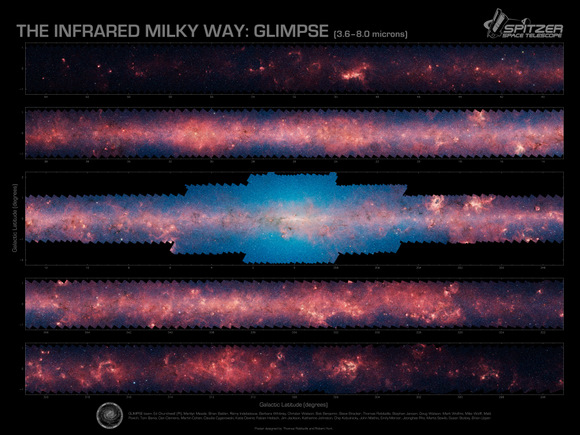
This “chops” up the image into five strips, and certainly isn’t as impressive as the 55 meter version! However, there’s another, more spectacular way to view this spectacular image. The GLIMPSE (Galactic Legacy Infrared Mid-Plane Survey Extraordinaire) Image Viewer provides a great way to view and browse this image. The viewer boasts the following tagline: “One spacecraft, 5 infrared bands, 800,000 images, 4 billion pixels of data.” It lets you scan the image with both the IRAC (Infrared Array Camera) on Spitzer, or the MIPS (Multiband Imaging Photometer.)
Watch Press Conferences on Astronomy Cast LIVE
UPDATE: NEW LINK for Noon conference
Wish you were here? Join us today from the AAS meeting in St. Louis. We’ll be live-streaming video of the press conferences on the Astronomy Cast UStream channel. You can participate via chat if you go to the link above, or watch it live below.
Today’s Press Conference schedule (all times CDT):
9:40 am: Weird Binary Stars
12:00pm: The Milky Way
Also, Pamela’s session at 10:00 am will be available live: Round Table: Connecting Local and National New Media Programs in the IYA 2009.
Re-use, Recycle and Share Your Spacecraft to Find Exoplanets
How do you get the most out of one spacecraft and find exoplanets in the process? Re-use, recycle and share. The spacecraft bus that brought the Deep Impact “impactor” to comet Tempel 1 in July of 2005 is still out in its heliocentric orbit and has been put to work double time where two new missions are sharing the same spacecraft. The combined operation is called EPOXI, which is a combo-acronym of the two separate missions. The Deep Impact Extended Investigation (DIXI) of comets will observe comet 103P/Hartley 2 during a close flyby in October 2010. But of current interest is the other half of the dynamic duo, called the Extrasolar Planet Observation and Characterization (EPOCh) which is observing stars already known to have transiting giant planets. Since the orbital plane of the giant planet has been identified, EPOCh is looking in that same plane for planets closer to Earth size. So far, 4 new planets have been found with this spacecraft, using the transit method. But EPOCh is also looking back at our home planet, using Earth as a baseline to be able to identify features on an exoplanet, such as continents and oceans.
The EPOXI team has focused most of its attention on the star GJ436. This red dwarf star which is 32 light-years from Earth has a Neptune-sized planet that transits in front of the star. Spitzer observations have shown its orbit to be oval shaped, or eccentric. “That virtually guarantees there is a second planet in this system,” said Drake Deming, Deputy Principal Investigator for EPOXI . “We have three weeks of data on this system. The habitable zone corresponds with where we believe this planet to be, and we hope to be below the Earth as far as the size.”
Earth observations will help to calibrate future observations of Earth-like exoplanets. EPOXI obtained a particularly interesting view of the Earth on May 29, when the Moon passed in front of the Earth as viewed from the spacecraft. This “transit” of the Moon is an event that may also be observed to occur for Earth-like exoplanets, and it may help us to deduce the nature of their surface features.
Deming and Deep Impact team leader Michael A’Hearn both said that sharing the spacecraft has gone smoothly. The EPOCh mission will continue until August 30 of this year, with the option of doing more planet searching if the team is able to preserve the margin of hydrazine fuel on board. “But,” said Deming, “when the hydrazine runs out we’re done for sure.”
Source: AAS press conference
Famous People Wandering the Halls of AAS
Walking the halls of the AAS meetings we found Galileo Galilei, who actually looks pretty good for being 440 years old. He had a briefing with officials from the inquisition (the media) and said that he has just returned from Rome on his book tour, promoting Sidereus Nuncius (Starry Messenger). But here, he met up with another author, Dava Sobel, who wrote “Galileo’s Daughter,†and is in St. Louis to speak at a public lecture in conjunction with the AAS meeting.
The International Year of Astronomy (IYA) which celebrates 400 years since Galileo looked through his telescope, is being promoted heavily here at the AAS meeting, which includes educational workshops and symposiums sponsored by the Astronomical Society of the Pacific, highlighting special educational programs specifically created for IYA.
Speaking of education, Galileo says that being a professor is difficult. “The work is hard and the pay is terrible,†he said. “I’m looking to invent something here during the next year which might give me some fame.â€
Galileo was played by Mark Thompson, an impersonator who actually is an amateur astronomer. Although he kind of transited back and forth to the present and the past, he said he’s currently living in IYA time, which means he hasn’t yet built his telescope. That will happen coming up next year.
More information about Mark Thompson as Galileo.
How To Weigh a Black Hole: Just Look At Its Galaxy
My father was a rancher, who had the uncanny ability to accurately estimate the weight of each animal in his herd of cattle simply by looking at them. Today, at the American Astronomical Society meeting in St. Louis, astronomers announced a new, simple way of determining masses of super-massive black holes by just looking at images of galaxies. Dr. Marc Seigar from the University of Arkansas at Little Rock has been studying images available at the Hubble Space Telescope archive site, and looking at the how tightly the galaxy’s arms wrap around itself in relation to the size of the galaxy’s super-massive black hole. “This provides a much simpler method of determining black hole mass,” said Seigar. “You just need an image of a galaxy and you can measure the tightness of the spiral structure. This can easily be applied to distant galaxies, up to 8 billion light-years away.”
Usually astronomers determine masses of super-massive black holes by looking at how fast the stars are moving in the central regions of the galaxies. But that method only works for nearby galaxies. Astronomers have been looking for a new method for galaxies that are father away. This new inexpensive method can use already-existing images, as Seigar has used from the Hubble Site.
Seigar and his team looked at photographs of 27 spiral galaxies including the Milky Way and the Andromeda Galaxy. They observed galaxies with the smallest black holes had spiral arms with angles up to 43 degrees between the arms and the central bulge. Those with the biggest black holes had spiral arms at angles of only 7 degrees between the arms and the bulge.
Seigar said its also possible that the main factor in determining the mass of a super massive black hole is the amount of central concentration of dark matter in a galaxy. “We think dark matter is driving most of the relationships between black holes and their galaxies,” he said. “The masses of these black holes can be determined indirectly from the characteristics of the light emitted from in falling material.”
Seigar will continue to use this method to verify his findings, as well as looking at other aspects. “We have to determine if the relationship between spiral arms and black hole mass evolves over time.”
Source: AAS press conference
Phoenix Digs on Mars
Phoenix’s first dig in the Martian soil. Image credit: NASA/JPL-Caltech/ University of Arizona
The Phoenix lander used its robotic arm scoop to dig up soil on Mars surface for the first time during its activities during its seventh day on the Red Planet. The image above shows the hole dug by Phoenix, and below is a picture of the scoop itself, with the Martian soil inside.
The plan was to do a test dig and then dump the soil. If that works correctly, then Phoenix will dig another scoop and bring it to the TEGA device on board the lander, the Thermal and Evolved Gas Analyzer, a “furnace” and mass spectrometer instrument that scientists will use to analyze Martian ice and soil samples.
During its previous day’s activities on Sol 6, Phoenix reached out and touched Mars with its robotic arm scoop to make an impression on the Martian surface. And please, no conspiracy theories here, but the impression looks like a footprint, and the Phoenix scientists have dubbed the mark “Yeti.” Touching the surface was a preliminary test for the robotic arm and scoop, to make sure everything was working correctly before making the first scoop.
However, the TEGA device has experienced an intermittent short circuit, and the TEGA scientists are developing a procedure to work around the problem. But Phoenix can still deliver the soil sample to TEGA, and the sample can be held there until the device is working.
Original News Source: Phoenix
Launchpad Damaged During Saturday’s Shuttle Launch
Debris falls into the water following Discovery’s launch on Saturday. Images from CBS Space Place.
The launchpad at Kennedy Space Center was damaged during Saturday’s space shuttle launch. Pictures taken during Discovery’s launch show debris raining down into the waterway just behind launchpad 39A. Additional images show debris that appears to be broken concrete littering a nearby road as well as damaged and buckled concrete on one side of the launchpad. CBS News’ Bill Harwood reported that the damage to the pad occured on the north side of the “flame trench” wall. The trench is used to divert exhaust from the shuttle’s solid rocket boosters.
The damage is “unusual,” Harwood quoted NASA spokesman Bill Johnson, who verified the damage was serious and tomorrow (Monday) a full report on the incident will be issued. Harwood also reported that a NASA manager said part of the pad’s base was repaired following a previous launch, but possibly something was either missed or not repaired correctly.

The debris appears to come from the lauchpad itself, and not the shuttle. And whether any of the debris hit the shuttle is currently unknown. The astronauts on board Discovery have not yet been able to conduct the usual inspection of the shuttle nose cap and wing leading edge panels because the 50-foot-long boom equipped with laser scanners and high-resolution cameras was unable to fit into the shuttle’s payload bay due to the large size of the Japanese Kibo laboratory that Discovery is bringing to the International Space Station. The last shuttle crew left the orbiter boom sensor system at the ISS, and the crew of Discovery will retrieve it while docked to the station. ISS crew members will take high resolution pictures of the shuttle as it approaches the station on Monday. Docking is scheduled about 2 pm EDT.
Both launchpads at KSC, 39A and 39B were originally built for the Apollo spacecraft/Saturn rockets and were modified for the space shuttles. During launches the pads must withstand both high heat and extreme pressure.
Original News Source: CBS Space Place
Get Ready for High-Energy GLAST
It’s not hard to grab someone’s attention when you mention the words “super massive black holes,” “gamma ray bursts,” “cosmic rays,” and ” dark matter.” NASA’s next space telescope will attempt to grab data about some of these high-energy objects in our universe to help us understand their mysteries. GLAST, the Gamma-ray Large Area Space Telescope will use its instruments to study those objects that generate gamma-ray radiation, the most energetic form of radiation we know of, billions of times more energetic than the type of light visible to our eyes. Liftoff for GLAST is set for Thursday, June 5, and the launch window extends from 11:45 a.m. to 1:40 p.m. EDT.
GLAST will reside in a circular, low Earth orbit of about 560 km ( 350 miles ). This orbit was chosen to minimize the effects of charged particles that surround Earth, and which would create additional unwanted background signals in the detectors. At that altitude, the observatory will circle Earth every 90 minutes. In sky-survey mode, GLAST will be able to view the entire sky in just two orbits, or about 3 hours.
The instruments on the GLAST mission are the Large Area Telescope (LAT) and the GLAST Burst Monitor. Lat has a tracker for gamma-ray detection and direction measurement, and can also measure the energies of the rays. The GBM will have two types of scintillators mounted on the sides of the spacecraft to detect electromagnetic waves.
Phil over at Bad Astronomy has a couple of very nice (and fun) videos with info about GLAST (one starring Phil himself), but these are the major goals of GLAST:
• Explore the most extreme environments in the Universe, where nature harnesses energies far beyond anything possible on Earth.
• Search for signs of new laws of physics and what composes the mysterious Dark Matter.
• Explain how black holes accelerate immense jets of material to nearly light speed.
• Help crack the mysteries of the stupendously powerful explosions known as gamma-ray bursts.
• Answer long-standing questions across a broad range of topics, including solar flares, pulsars and the origin of cosmic rays.
GLAST should provide some very interesting data about these spectacular and remarkable objects in our universe, and will create a full-sky map of gamma radiation.
Kapla GLAST!
Source: GLAST site
It Really Looks Like Ice on Mars
Take a look at this image sent back from the Phoenix lander. On Friday, Phoenix scientist Ray Arvidson said there may be ice directly under the Phoenix lander, exposed in the blast zone by the retrorockets used for Phoenix’s soft landing. Friday’s image showed a small portion of the exposed area that looks brighter and smoother than the surrounding soil. On Saturday, Sol 5 for Phoenix on Mars, a new image shows a greater portion of the area under the lander. Scientists say the abundance of excavated smooth and level surfaces adds evidence to a hypothesis that the underlying material is an ice table covered by a thin blanket of soil. This is just what the Phoenix mission was hoping to find, and how incredible to land directly over your goal.
The bright-looking surface material in the center, where the image is partly overexposed, may not be inherently brighter than the foreground material in shadow. But the scientists are calling this area “Holy Cow.” Reportedly (via Emily at the Planetary Society) that’s exactly the phrase exclaimed when this image was returned. More pictures of this feature will be imaged using different exposures in an effort to determine if this really is ice.
The other interesting aspect of this image is that the retrorocket nozzles are visible right at the top of the image.
We’ll keep you posted when there’s more information and data available on the area under the lander.
Sources: Phoenix, Planetary Blog
Phoenix Spies Possible Ice; TEGA Short Circuit Likely
Scientists from the Phoenix mission say the lander may have exposed ice just beneath Mars surface when soil was blown away as the spacecraft landed last Sunday, May 25. The possible ice appears in an image the robotic arm camera took underneath the lander, near a footpad. The robotic arm was moved so the camera could peer beneath the lander to make sure Phoenix’s footing is secure before any digging operations start. In the top center of the image above is the area in question.
“We could very well be seeing rock, or we could be seeing exposed ice in the retrorocket blast zone,” said Ray Arvidson of Washington University, St. Louis, Mo., co-investigator for the robotic arm. “We’ll test the two ideas by getting more data, including color data, from the robotic arm camera. We think that if the hard features are ice, they will become brighter because atmospheric water vapor will collect as new frost on the ice.”
Arvidson said in today’s Phoenix press conference that Phoenix will provide full confirmation of what lies below the lander when it excavates and analyzes layers in the nearby landscape.
One bad piece of news for the nearly flawless mission, however. The Thermal and Evolved Gas Analyzer (TEGA) instrument that “bakes and sniffs” samples to identify the chemical make-up of the soil might have a short circuit. In a test conducted on Thursday, the instrument exhibited electrical behavior consistent with an intermittent short circuit in the spectrometer portion. The team is currently developing diagnostic steps that will be sent to the lander in the next few days. TEGA includes a calorimeter that tracks how much heat is needed to melt or vaporize substances in a sample, plus a mass spectrometer to examine vapors driven off by the heat.
“We have developed a strategy to gain a better understanding of this behavior, and we have identified workarounds for some of the possibilities,” said William Boynton of the University of Arizona, Tucson, lead scientist for the instrument.
The latest data from the Canadian Space Agency’s weather station shows another sunny day at the Phoenix landing site with temperatures holding at minus 30 degrees Celsius (minus 22 degrees Fahrenheit) as the sol’s high, and a low of minus 80 degrees Celsius (minus 112 degrees Fahrenheit). The LIDAR instrument was activated for a 15-minute period just before noon local Mars time, and showed increasing dust in the atmosphere.
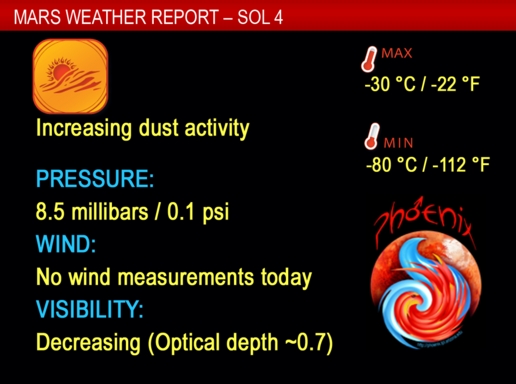
If you’d like to download this Phoenix weather widget for your desktop, check HERE.
“This is the first time LIDAR technology has been used on the surface of another planet,” said the meteorological station’s chief engineer, Mike Daly, from MDA in Brampton, Canada. “The team is elated that we are getting such interesting data about the dust dynamics in the atmosphere.” HERE is an animation of the LIDAR
The mission passed a “safe to proceed” review on Thursday evening, meeting criteria to proceed with evaluating and using the science instruments.
“We’re still in the process of checking out our instruments,” Phoenix project scientist Leslie Tamppari of JPL said. “The process is designed to be very flexible, to respond to discoveries and issues that come up every day. We’re in the process of taking images and getting color information that will help us understand soil properties. This will help us understand where best to first touch the soil and then where and how best to dig.”
And finally, here’s the latest version of Phoenix’s panorama, compiled of images from Phoenix’s Stereo Surface Imager (SSI) camera that were taken on sols 1 and 3. The top portion has been stretched eight fold to show details of features in the background. Phoenix’s parachute, backshell, heatshield, and impact site can also be seen.



